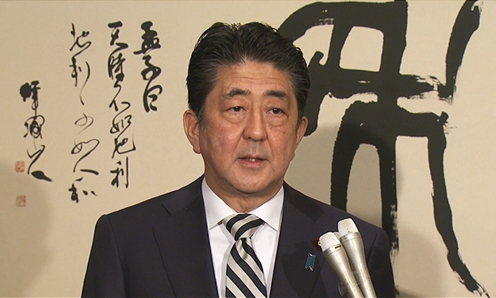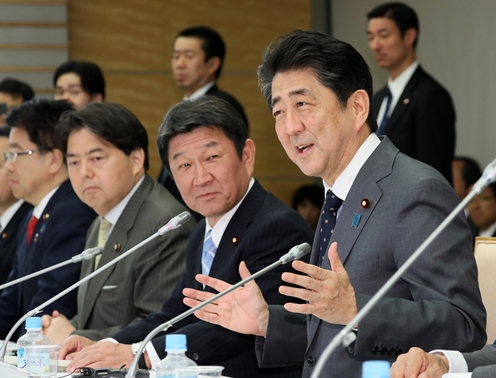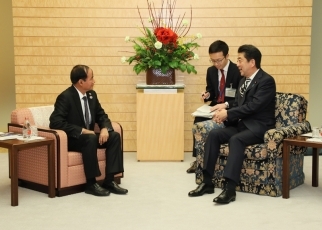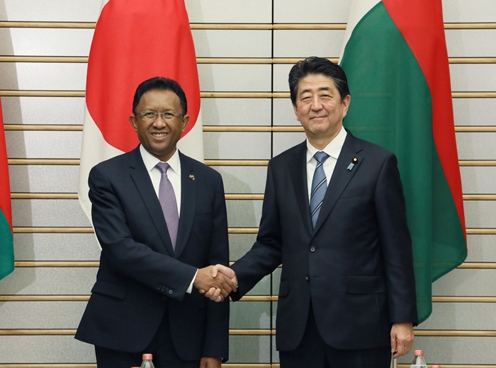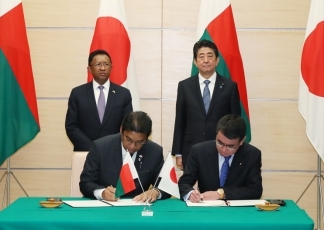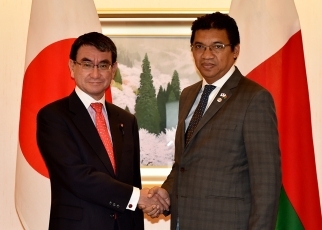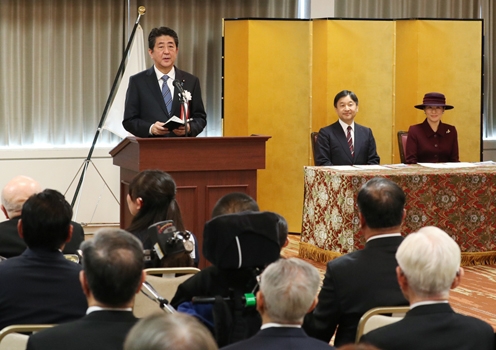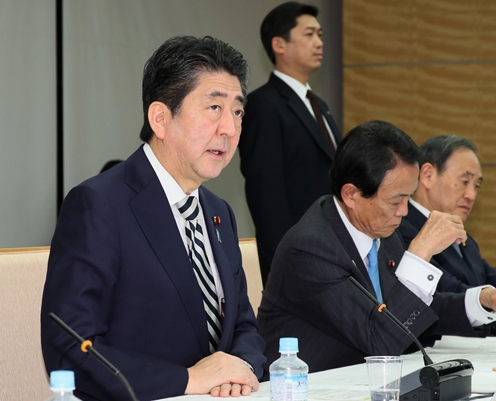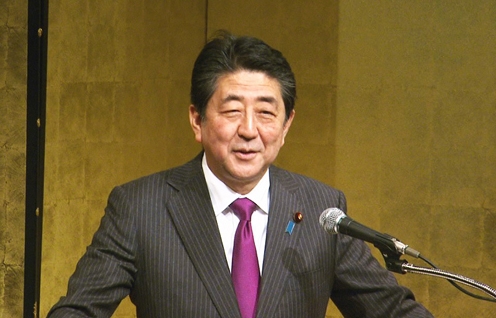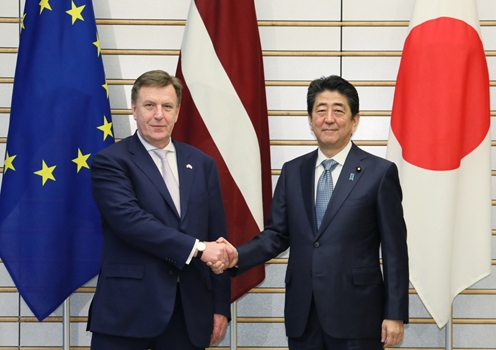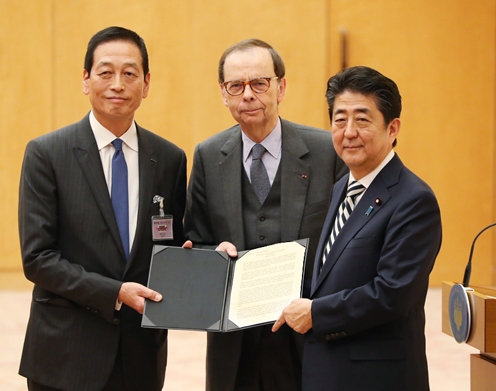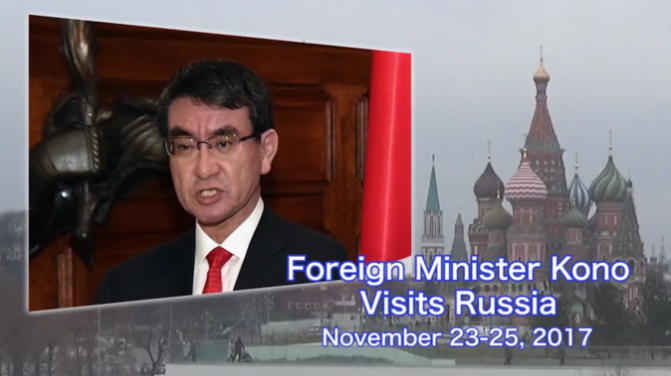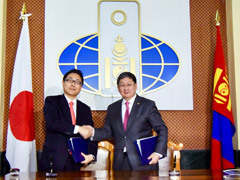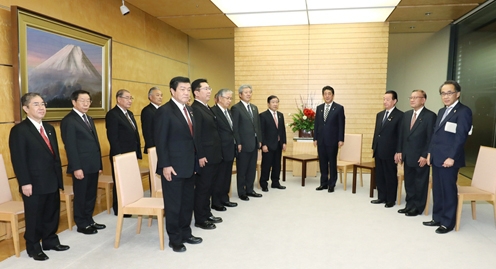Press Occasion on the Imperial Household Council Meeting.
Cabinet Secretariat, Friday, December 1, 2017
On December 1, 2017, Prime Minister Abe held a press occasion at the Prime Minister's Office.
The Prime Minister stated on the Imperial House Council meeting as follows:
Today an Imperial House Council meeting was held. The Council decided on the view that the Special Measures Law on the Imperial Household Law should be put into effect on April 30, 2019.
The abdication of His Majesty the Emperor will be the first in about 200 years and the first such case in our constitutional history. Today the view of the Imperial House Council was decided smoothly and a great deal of progress was made towards the succession of the Imperial Throne, filling me with deep emotion.
Based on this view of the Imperial House Council, the government will swiftly enact a cabinet order stipulating the day the Special Measures Law is to enter into effect. We will put forth every possible effort to ensure that the abdication of His Majesty the Emperor and the accession of His Highness the Crown Prince to the Imperial Throne takes place without incident amidst the good wishes of the Japanese people.
Council for Designing 100-Year Life Society
Cabinet Secretariat, Thursday, November 30, 2017
[Provisional Translation]
On November 30, 2017, Prime Minister Shinzo Abe held the third meeting of the Council for Designing 100-Year Life Society at the Prime Minister’s Office.
At the meeting, debate took place on recurrent education (continuing education) and university reform.
Based on the discussion, the Prime Minister said,
“At the start of the discussion, Mr. Sakakibara (Mr. Sadayuki Sakakibara, Chairman, Keidanren (Japan Business Federation) and member of the Council) responded to the Government’s request for around 300 billion yen in funds from the business community. He stated that, with the major premise of the consumption tax rate being raised to 10%, the business community will provide up to a maximum of 300 billion yen in phases from the perspective of encouraging supports to corporate employees for continuing their job and balancing work and child-rearing. I’m afraid if it appears to reconfirm this once again. In response to the statement made by Mr. Sakakibara, I would just like to say a few words.
We will receive the cooperation of the business community for realizing the Plan for Raising Children with Peace of Mind, which is aimed at eliminating childcare waiting lists, an urgent issue facing Japan. I would like to once again extend my appreciation for this cooperation.
At the same time, the business community requested that the Government consider measures to mitigate the burden such as lowering labor insurance rates as the employment situation has been improved. We will consider the request regarding labor insurance rates while taking into account trends in social security finances and also examine other measures for supporting small- and medium-sized enterprises.
In addition, Today, we kicked off discussions on recurrent education and university reform. I would like to express my appreciation to Dr. Lynda Gratton for taking time out of her busy schedule and coming all the way from London to join us today.
We will create a society where people can go back to school anytime and start over. With the aim of building a 100-year life society, we will consider to improve recurrent education, which will be the key to achieving this aim. We will also create an environment in which anyone, regardless of their age, has a chance to challenge themselves to take on new endeavors, by supporting the current generation to advance their careers, and assisting middle-aged and older workers in finding new employment, among other measures.
Based on the comments we received today, we will accelerate discussions towards finalizing the basic concept within the first half of next year.
The Government will compile a new economic policy package in early December. At the next meeting of this council in mid-December, I ask that you compile the interim report of the Council for Designing 100-Year Life Society, taking into consideration of this policy package.”
Courtesy Call on Prime Minister Abe, by Rt. Hon. Mr. Win Myint, Speaker of the Pyithu Hluttaw
Foreign Affairs, Friday, December 1, 2017
On December 1, (commencing from 3:10 p.m. for approximately 20 minutes), Mr. Shinzo Abe, Prime Minister of Japan, received a courtesy call by Rt. Hon. Mr. Win Myint, Speaker of the Pyithu Hluttaw of the Republic of the Union of Myanmar, visiting Japan with the invitation by the House of Representatives of Japan. The overview is as follows.
1. At the outset, Prime Minister Abe welcomed Speaker Win Myint’s visit to Japan for the first time, expressed his respect for progress and achievement of democratization and stated that Japan will continue to cooperate for democratization and economic development of Myanmar.
2. Prime Minister Abe stated that Japan will accelerate cooperation focusing on development of Yangon, transportation and electricity and reiterated Japan’s contribution to provide assistance up to 125 billion JPY to Myanmar, which had been announced in the meeting with State Counsellor Aung San Suu Kyi in November. He also noted that Japan stands ready to provide its maximum support to the efforts for improving the situation in Rakhine State, including return of displace persons. Prime Minister Abe conveyed his intention to continuously facilitate progress of the peace process with the ethnic minorities, with collaboration by Mr. Yohei Sasakawa, Special Envoy of the Government of Japan for National Reconciliation in Myanmar.
3. In response, Speaker Win Myint expressed his gratitude for Japan’s support for democratization, national reconciliation, peace process and social and economic development of Myanmar and his wish for further deepening of friendship and cooperation between the governments, parliaments and people of both countries.
4. Prime Minister Abe also stated that Japan cannot tolerate the launch of an intercontinental-class ballistic missile by North Korea and requested Myanmar’s cooperation for fully implementing the relevant United Nations Security Council resolutions. Speaker Win Myint replied that Myanmar, while recognizing the importance of nonproliferation and elimination of nuclear weapons, cooperates to steadily implement the United Nations Security Council resolutions, in the spirit of contributing to peace and stability in the region.
Japan-Madagascar Summit Meeting and Other Events
Cabinet Secretariat, Tuesday, December 5, 2017
On December 5, 2017, Prime Minister Shinzo Abe held a summit meeting and other events with H.E. Mr. Rakotoarimanana Hery Martial Rajaonarimampianina, President of the Republic of Madagascar, at the Prime Minister's Office.
The two leaders attended a salute and guard of honor ceremony, and then held a summit meeting. Thereafter, the leaders held a signing ceremony and a joint press announcement.
Exchange of Notes concerning Grant Aids to Madagascar
Cabinet Secretariat, Tuesday, December 5, 2017
1. On December 5, following the Japan-Madagascar Summit Meeting held in Tokyo, Mr. Taro Kono, Minister for Foreign Affairs, and H.E. Mr. Henry Rabary-Njaka, Minister of Foreign Affairs of the Republic of Madagascar, exchanged notes concerning two grant aid projects (670 million yen in total), in the presence of Mr. Shinzo Abe, Prime Minister of Japan, and H.E. Mr. Rakotoarimanana Hery Martial Rajaonarimanpianina, President of Madagascar.
2. The overview of the projects is as follows:
(1) Support for food security in Madagascar (“Food Assistance” grant aid; grant amount of 470 million yen)
Madagascar faced a rainfall shortage due to unseasonable weather from late 2016 to early 2017, and it also suffered flood damage from a major cyclone this March, resulting in a decline in the size of its rice harvest. Furthermore, the country’s southern region constantly faces droughts caused by El Nino, and as a result around 2.1 million citizens are suffering from food shortages. With this grant aid, the Government of Japan will implement food assistance by providing 7,000 to 8,000 tons of rice to Madagascar, for the purpose of enhancing the country’s food security and improving the state of nutrition.
Japan pledged to promote food security in Africa at the Sixth Tokyo International Conference on African Development (TICAD VI), which was held in August 2016, and this grant aid will contribute to realizing that pledge.
(2) Support for improving access to safe water in Madagascar (“The Economic and Social Development Programme” grant aid; grant amount of 200 million yen)
In Madagascar, around half the country’s citizens utilize uncontrolled sources of water such as rivers, lakes and marshes. Access to safe water is limited, and waterborne diseases caused by unsanitary water are rampant. With this grant aid, Japan will contribute water purification systems to Madagascar’s Ministry of Water, Energy and Hydrocarbon, for the purpose of improving access to safe water in Madagascar.
Japan pledged to improve access to safe water and hygiene for 10 million people at TICAD V, which was held in June 2013, and this grant aid will contribute to realizing that pledge.
[Reference] Japan-Madagascar Relations (Basic Data)
Madagascar’s total land area is approximately 590,000 square kilometers (approximately 1.6 times that of Japan), its population is approximately 24.89 million people (2016, World Bank) and its Gross National Income (GNI) per capita is 400 US dollars (2016, World Bank).
Japan-Madagascar Foreign Ministers’ Meeting
Foreign Affairs, Monday, December 4, 2017
On December 4, commencing at approximately 5:25 p.m. for around 30 minutes, Mr. Taro Kono, Minister for Foreign Affairs, held a foreign ministers’ meeting with H.E. Mr. Henry Rabary-Njaka, Minister of Foreign Affairs of the Republic of Madagascar, who is accompanying H.E. Mr. Rakotoarimanana Hery Martial Rajaonarimampianina, President of Madagascar, on the president’s official visit to Japan. The overview of the meeting is as follows.
1. Minister Kono welcomed Minister Rabary-Njaka to Japan, and explained that Japan has been promoting the Free and Open Indo-Pacific Strategy and hopes to proactively cooperate with Madagascar in this regard. Minister Kono also stated that Japan intends to contribute to Madagascar’s economic and social development and improve regional connectivity through a range of cooperation, including the expansion of the Toamasina Port. In response, expressing gratitude for Japan’s support, Minister Rabary-Njaka stated that he agrees with the points Minister Kono raised, and he hopes to further strengthen the long-standing friendship between the two countries. Minister Rabary-Njaka also expressed his intention to promote Madagascar’s economic reform and social stability placing Japan as a role model.
2. The two ministers exchanged views on the North Korea issue. With regard to the North Korea situation that Japan is facing, Minister Rabary-Njaka stated that North Korea’s nuclear tests and missile development constitute grave threats to global peace and stability, and confirmed solidarity between Madagascar and Japan. Minister Rabary-Njaka also expressed understanding for Japan’s position on the abduction issue.
3. In addition, the two ministers exchanged views on issues such as cooperation in the international arena, including United Nations Security Council (UNSC) reform.
Awards Ceremony Related to the FY2017 Week of Persons with Disabilities
Cabinet Secretariat, Tuesday, December 5, 2017
On December 5, 2017, Prime Minister Shinzo Abe held the Awards Ceremony Related to the FY2017 Week of Persons with Disabilities in Tokyo, in the presence of Their Imperial Highnesses the Crown Prince and Crown Princess.
In his opening address, the Prime Minister made the following remarks,
“As the host, I would like to offer a few remarks on the occasion of the Awards Ceremony Related to the FY2017 Week of Persons with Disabilities, which is being held in the presence of Their Imperial Highnesses the Crown Prince and Crown Princess.
I am truly delighted today to present the awards to honor the achievements of the recipients who are involved in the promotion of national understanding of disabilities, consideration for people with disabilities, and the improvement of welfare, toward the realization of an inclusive society in which all people, regardless of whether they have a disability, mutually respect and support each other’s characters and individuality, and can be active and enjoy a life that suits them.
The essays and posters created by the award recipients today candidly reveal love for family members with disabilities or the courage to face one’s own disabilities, and the new discoveries and growth that have arisen as a result. They are all wonderful works and touched me deeply.
In addition, the people who are receiving awards for distinguished contributions today have stood up for persons with disabilities in their respective fields for many years, and earnestly built up their achievements in succession, toward the improvement of the welfare of persons with disabilities. I would like to once again express my deep respect for the efforts and contributions of all the recipients, who form the basis of policies regarding persons with disabilities and some of whom also themselves serve as models for the independent participation in society of persons with disabilities.
I strongly hope that today’s awards will further promote understanding of disabilities and consideration for persons with disabilities by all the people of Japan. The Government pledges to continue to exert its full efforts toward the realization of an inclusive society. I would like to conclude my remarks by expressing my wish for the continued health and success of all of you, and even greater development of your endeavors.”
His Imperial Highness the Crown Prince Grants Audience to Participants of the JICA Knowledge Co-Creation Program
JICA, Friday, December 1, 2017
Nine participants in JICA's knowledge co-creation program National Government Administration for Senior Officials were granted an audience with His Imperial Highness Crown Prince Naruhito at the Crown Prince's Residence on Oct. 19.
The program started in 1985 to enhance the policy-formation ability of senior government officials responsible for policy-making. Many former participants have held governmental positions in their own countries and become mediators between their countries and Japan.
This year, participants heard many lectures and visited sites including the National Personnel Authority, Katsushika City Office, and the Disaster Reduction and Human Renovation Institution. Also, participants learned through discussions among themselves.
After remarks by Emiko Matsuo, director general for Secretariat’s Policy Matters, National Personnel Authority, the participants had a pleasant chat with His Imperial Highness Crown Prince Naruhito.
Ms. K. M. S. D. JAYASEKARA
(Additional Director General, Training and Development Administration and Finance, Sri Lanka Institute of Development Administration, Sri Lanka)
I must say that I was honored and privileged to have the opportunity to meet the Crown Prince of Japan. It was a very impressive experience for the delegation coming from different parts of the globe to have this rare opportunity. The Crown Prince had a vast knowledge about the countries we were from and we shared our ideas and emotions not only about the Japan but also our motherlands. He knew about Sri Lankan landmarks like the Temple of the Sacred Tooth in Kandy, Sri Lanka. The wisdom, maturity and friendship was remarkable and we were so happy and lucky to have this experience with the Crown Prince in Japan.
Mr. Mohammad-Omar ARYAN
(Director of Labor Policy and Capacity Building of Human Resource, Ministry of Economy, Afghanistan)
Participation in a knowledge co-creation program funded by JICA provided me the chance to attend an audience with His Highness the Crown Prince of Japan. I was impressed by his noble personality and kindness.
Japan is a land of ethics and being well-mannered. The people are so friendly and respectful regardless of their social status. The hospitality of the Crown Prince is a great sign of the rich culture of extraordinary Japan.
Arigato gozaimasu, Crown Prince.
Meeting of the Council on Economic and Fiscal Policy
Cabinet Secretariat, Friday, December 1, 2017
[Provisional Translation]
On December 1, 2017, Prime Minister Shinzo Abe held the 16th meeting in 2017 of the Council on Economic and Fiscal Policy at the Prime Minister's Office.
At the meeting, there was discussion on the Policy of “Basic Principles of FY2018 Budget Formulation,” and Integrated Economic and Fiscal Reforms.
Based on the discussion, the Prime Minister said,
“First, we received a report on the Policy of “Basic Principles of FY2018 Budget Formulation.” Toward the formulation of the budget for next year, we will advance steady efforts to achieve fiscal soundness, while also aiming for the creation of a more focused budget, including taking the necessary budgetary measures for important policy issues, such as the revolutions on human resources development and productivity. I want the relevant ministers, including Minister Motegi and Minister Aso, to thoroughly handle these issues.
Second, we had a discussion on social security reform. A direction has been set entailing reconsidering the framework being used with the drug pricing system to promote the creation of revolutionary new pharmaceuticals, advancing remote diagnoses, and strengthening measures to secure personnel in the medical, nursing care, and childcare fields. I would like Minister Kato to steadily implement these items based on today’s discussion.
In addition, a direction has been set for the reform of the administrative and financial systems of local governments. We will further promote efficiency at administrative procedure offices strengthen third sector management reforms, and advance the effective utilization of public facilities as well as measures to deal with the aging of those facilities. I would like Minister Noda to steadily implement this based on today’s discussion.”
Welcome Reception for the Third Japan-China Business Leader and Former High-Level Government Official Dialogue (Japan-China CEO Summit)
Cabinet Secretariat, Monday, December 4, 2017
[Provisional Translation]
On December 4, 2017, Prime Minister Shinzo Abe attended the welcome reception for the Third Japan-China Business Leader and Former High-Level Government Official Dialogue (Japan-China CEO Summit) held in Tokyo.
The Prime Minister said in his address,
“First, I want to offer my heartfelt welcome to everyone from the Chinese business community visiting Japan, including Mr. Zeng Peiyan, Chairman of the China Center for International Economic Exchanges. This is already the third Japan-China CEO Summit, which gathers together distinguished corporate executives from Japan and China. There is a Japanese saying, ‘Peach and chestnut seeds take three years to bear fruit, persimmons take eight.’ It means it takes time to bear the fruit of your actions. I see here the seeds planted through the hard work of former Prime Minister Fukuda and Chairman Zeng are now producing tremendous fruit.
I often say that Japan and China maintain an inseparable relationship. Materials and semi-finished products that can only be made in Japan are exported to China, which are then assembled into finished products in China and exported around the world. Having said that, our mutually beneficial economic relationship between Japan and China is not limited to bilateral trade. It is a relationship that is brimming with even greater possibilities.
The Asian Development Bank (ADB) estimated that the annual demand for infrastructure would rise to 1.7 trillion dollars by 2030 in Asia. Meanwhile, only about 900 billion dollars is actually being invested. Investments have not caught up with the demand.
The cooperation between Japan and China to meet this robust infrastructure demand in Asia will not just boost the economic growth of our two countries, but also contribute greatly to the prosperity of people in Asia.
Of course, we need to ensure the economic viability of the projects, and the fiscal soundness of the countries carrying out infrastructure development must not be undermined. Otherwise we will not be able to realize sustainable growth.
Moreover, it must be accessible to everyone and open to anyone. The infrastructure development needs to be carried out through a transparent and fair process. I am certain that open economic activities will be the force for creating new innovation.
I hope to make the region stretching from the Pacific Ocean to the Indian Ocean a free and open area that is based on fair rules. These vast waters should be a global public good that brings peace and prosperity to all people into the future, without discrimination.
I believe that under this Free and Open Indo-Pacific Strategy, Japan can cooperate significantly with China which has put forward the One Belt, One Road initiative.
At the recent Japan-China summit meeting, I proposed that we also work together to develop businesses in countries other than Japan and China, going beyond the usual promotion of trade and investment between our two countries. President Xi Jinping and Premier Li Keqiang and I were able to reach a shared understanding regarding this.
In that sense, I have sincere expectations that this Japan-China CEO Summit will mark a new start in cooperative relations between the Japanese and Chinese business communities.
Exactly 45 years ago, then Prime Minister Tanaka was able to achieve the normalization of Japan-China relations through a series of frank and candid discussions with then President Mao Zedong and then Premier Zhou Enlai. When asked later about what led him to speak so frankly with his Chinese counterparts, former Prime Minister Tanaka stated that a summit meeting was not simply a forum for diplomatic negotiations, but was a meeting that became the foundation for longstanding Japan-China relations into the future.
At the summit meeting last month, I also had frank and extremely in-depth exchanges with President Xi Jinping on a variety of issues, including the situation in North Korea. If I may refer to President Xi’s remarks at that time, the meeting truly marked a new start for Japan-China relations. I am in total agreement with him.
I would like to welcome Premier Li Keqiang to Japan, by holding a Japan-China-Republic of Korea summit meeting as soon as possible. With next year marking a major milestone of the 40th anniversary of the Treaty of Peace and Friendship between Japan and the People’s Republic of China, I wish to visit China at an appropriate time and I hope President Xi will visit Japan as early as possible as well. Through such high-level mutual visits, I hope to elevate Japan-China relations to a new height.
I have heard that the joint mission to China with the Japan-China Economic Association two weeks ago was a tremendous success, which was attended by Chairman Sakakibara of Keidanren (Japan Business Federation) who is also here today. I understand that Premier Li held talks for an hour, the longest of its kind, with the largest delegation of its kind consisting of 250 people. Having heard this, I have made my speech today the longest ever for this summit, longer than my previous speech,said that the Treaty of Peace and Friendship between Japan and the People’s Republic of China became possible only after gaining the understanding and cooperation of the people. At times, former Prime Ministers Kakuei Tanaka and Takeo Fukuda had an intense rivalry within the Liberal Democratic Party of Japan (LDP) back then. Both were also convinced that paving a way for the relationship with China would benefit Japan and this region.
Today, I stand before you as someone who descends from former Prime Minister Takeo Fukuda, with cooperation from Mr. Toshihiro Nikai who descends from former Prime Minister Kakuei Tanaka.
I am convinced that broadening exchanges and cooperation at every level between the people of our two countries will serve as a driving force to carve out a new era of the Japan-China relationship. In 2020, and then in 2022, we will see the opening of the Tokyo Olympic and Paralympic Games and the Beijing Olympic and Paralympic Games in succession. I would like to make use of these opportunities to greatly strengthen exchanges among young people who will lead our future. I hope to dramatically expand exchanges between the people of Japan and China in fields such as the economy, culture, and sports.
In this regard as well, this Japan-China CEO Summit has an ever growing role. I would like to close my remarks by expressing my hope that the deep ties among all of you will act as a strong force for the further improvement of the Japan-China relationship. Thank you very much.”
Japan-Latvia Summit Meeting and Other Events
Cabinet Secretariat, Wednesday, December 6, 2017
On December 6, 2017, Prime Minister Shinzo Abe hosted a summit meeting and other events with H.E. Mr. Māris Kučinskis, Prime Minister of the Republic of Latvia, at the Prime Minister's Office.
The two leaders attended a salute and guard of honor ceremony, and then held a summit meeting. Thereafter, the leaders held a joint press announcement.
Courtesy Call from the Japan-France Club
Cabinet Secretariat, Friday, December 1, 2017
[Provisional Translation]
On December 1, 2017, Prime Minister Shinzo Abe received a courtesy call from the Japan-France Club at the Prime Minister's Office.
The Prime Minister said in his address,
“I would like to welcome those members of the Japan-France Club who are visiting Japan. The Japan-France Club is an important bridge for the special partnership between our two countries. On the occasion of the meeting in Japan of the Japan-France Club, I would like to express my heartfelt respect for the hard work of all of the Club’s members, including the Japan-France Club Co-chairs Mr. Masahiko Uotani, President and Group CEO of Shiseido Co., Ltd, and Mr. Louis Schweitzer, Special Representative of the Minister of Foreign Affairs and International Development of the French Republic for France-Japan Partnership. Japan and France have a special partnership sharing fundamental values such as freedom, democracy, human rights, and the rule of law. In a world where uncertainty is rising, I would like our two countries to cooperate to respond to the shared issues facing the international community, including upholding free trade and the response to the North Korea issue.
The agreement in principle on the Japan-EU Economic Partnership Agreement (EPA) that was reached in July was a clear indication of the will of Japan and the EU to continue to raise the flag of free trade high amidst the rising global trend towards protectionism. I have high expectations of continued strong leadership from France toward the early signing and entry into force of that agreement. Once this EPA is signed, Japanese consumers will be able to enjoy the wonderful products of France, such as French wine, for cheaper prices than before. I would also like the people of France to enjoy not only Japan’s industrial products, but our agricultural products as well. I look forward to all of this.
In the early morning of November 29, North Korea launched a ballistic missile with a range large enough to reach Paris. Reflecting on the fact that North Korea has already scrapped promises it has made in the past twice, dialogue for the sake of dialogue has no value. We must create a situation in which the international community cooperates in a unified manner to apply the maximum amount of pressure to North Korea, such that North Korea comes to the point where it tell us that it wants to discuss abandoning its development of nuclear weapons and ballistic missiles.
Lastly, next year, Japonismes 2018 will at last be held. I will attend the opening ceremony in Paris together with President Macron in July. While receiving the support of your companies representing Japan and France, I would like to build up momentum for an event that will serve as a new bridge between Japan and France. Thank you.”
Press Conference by Foreign Minister Taro Kono
Foreign Affairs, Tuesday, December 5, 2017
Q&A Format for Press Conferences
Mr. Taro Kono, Minister for Foreign Affairs: In doorstep interview-style press conferences, while I have tried to explain carefully, when there is not a lot of time, such as when there is a committee meeting right afterwards, please submit a formal request for an interview for matters that require a lengthy explanation, as much as possible, so that I can provide a thorough response. Furthermore, I would like to point out that other reporters are inconvenienced as well when questions cover matters that cannot be answered in a short amount of time, while knowing that there is not much time available.
Opening Remarks
(1) Adoption of Draft Resolution on Nuclear Disarmament Submitted by Japan to the United Nations General Assembly
Minister Kono: A short while ago, on December 4, local time, the draft resolution on nuclear disarmament submitted by Japan to the Plenary Meeting of the United Nations (UN) General Assembly in New York was adopted with the support of 156 countries.
We are very pleased that the resolution obtained support from a wide range of countries, including the nuclear-weapon states of the United States, the United Kingdom, and France, together with other 95 countries that supported the adoption of a legally binding instrument to prohibit nuclear weapons.
I am encouraged that the total number of countries reached 156 with an increase of 12 countries from the 144 countries that supported the adoption in the First Committee.
(2) Election of International Criminal Court Judge
Minister Kono: An election of the judges of the International Criminal Court (ICC) took place today, in the afternoon of December 4 New York time, and candidate Tomoko Akane (Ambassador for International Judicial Cooperation and Public Prosecutor of Supreme Public Prosecutors Office of Japan) was elected with the most number of votes, garnering 88 votes.
I understand that two people, including Ambassador Akane, were elected in the first vote. The result was not decided for the other 10 candidates in the first vote.
I believe that Ambassador Akane as well as Japan’s stance of active involvement in advancing international criminal law and humanitarian law through the ICC are highly regarded. This is a significant outcome.
UN Under-Secretary-General for Political Affairs Feltman’s Visit to North Korea
Reporter: It has been announced that UN Under-Secretary-General for Political Affairs Jeffery Feltman will visit North Korea. Please explain your thoughts on this visit.
Minister Kono: Japan has extensively exchanged views regarding the issue of North Korea with the UN Secretariat. I believe Mr. Feltman will go to North Korea and fully advocate to the North Korean regime about the need to change its current policy. That is our expectation.
Reporter: The North Korean side requested political dialogue amid the strengthening of sanctions against the country. What is your view of this North Korean conduct?
Minister Kono: I believe sanctions are starting to have a considerable impact. We hope North Korea recognizes that it does not have a bright future if it continues along this course and, change its policy.
Meeting on North Korea Co-organized by the United States and Canada
Reporter: I have a question about the call for a meeting of nations that contribute military forces to the UN Command related to the situation in North Korea from the United States and Canada. Some media have reported that the Japanese Government was asked about a meeting in December, but rejected it. Please clarify the related facts.
Minister Kono: It is true that the Canadian Government communicated us that they would like to hold consultations regarding North Korea. However, Japan explained that the meeting might not come together because of the close timing to the UN Security Council meeting and the likelihood that many of the countries invited to the meeting are attending the Security Council meeting, and the Canadian Government told us that they will change the timing.
I see here and there that the meeting is referred to as a meeting of nations that contribute military forces to the UN Command, but this was not the initial intention at all. I suspect someone started using this term at some stage, but countries that contribute military forces to the UN Command include countries that are not particularly related to the current situation in North Korea. Or, it might be misleading to say not related. They include countries that are somewhat far away in terms of both distance and geography. Japan thus communicated at the time that the participating countries should be narrowed down a little further. In any case, a variety of discussions continue to take place regarding this issue.
Draft Resolution on Nuclear Disarmament
Reporter: Going back to the UN draft resolution, fewer countries supported the adoption compared to last year’s draft resolution. Some have cited pullback in the content, expressions, and other aspects. Atomic bomb survivors and others have also noted a decline in Japan’s influence as the government of a country that has suffered atomic bombings. What are your thoughts on this point?
Minister Kono: Ninety-five of the countries that agreed with a legally binding instrument to prohibit nuclear weapons supported the adoption of the draft resolution. Furthermore, the United States, the United Kingdom, and France supported the adoption, in particular, the United States and the United Kingdom were co-sponsors. Japan’s draft resolution received the most support among the draft resolutions regarding nuclear disarmament and non-proliferation submitted to the current UN session. We perceive that our draft resolution is supported by a variety of countries and countries with various perspectives.
Japan-China High-Level Consultation on Maritime Affairs
Reporter: The Japan-China High-Level Consultation on Maritime Affairs will be starting. Please share with us your expectations for a Maritime and Aerial Communication Mechanism and outlook.
Minister Kono: I believe it will be taking place in Shanghai. I hope there will be a wide range of exchanges of views and discussions.
World Assembly for Women: WAW!2017
YouTube, Wednesday, December 6, 2017
World Assembly for Women: WAW!2017
Prime Minister Abe to attend UHC Forum 2017, The Secretary-General of the United Nations and the President of the Republic of Senegal to visit Japan
Foreign Affairs, Tuesday, December 5, 2017
1. Mr. Shinzo Abe, Prime minister of Japan will attend UHC (Universal Health Coverage) Forum 2017 to be held at the Tokyo Prince Hotel on December 14. This forum is expected to enhance the momentum on the global promotion of UHC.
2. H. E. Mr. António Manuel de Oliveira Guterres, Secretary-General of the United Nations, will pay an Official Working Visit to Japan from December 13 to December 14, 2017 to attend the Forum. This will be H. E. Mr. Guterres’ first visit to Japan as the Secretary-General. During his stay in Japan, Mr. Abe will hold a meeting with the Secretary-General and host a luncheon in his honor.
3. H.E. Mr. Macky Sall, President of the Republic of Senegal, will also pay a visit to Japan from December 11 to Decemeber 14 upon the invitation of Mr. Abe to the Forum. During his stay in Japan, Mr. Abe will hold a meeting with the President and host a dinner in his honor.
4. It is expected that their visits will give momentum to further deepening the cooperative relations between Japan and the United Nations as well as Japan and the Republic of Senegal.
[Reference 1] Universal Health Coverage (UHC)
To ensure that all people can receive the health services they need at an affordable cost throughout life.
[Reference 2] UHC(Universal Health Coverage) Forum 2017
On December 13 and 14, the International Conference will be held, co-organized by the Ministry of Foreign Affairs; the Ministry of Finance; the Ministry of Health, Labour and Welfare; the Japan International Cooperation Agency; the World Bank; the World Health Organization; UNICEF; and UHC2030. The Side Events will be organized on December 12 and 15. The Main Events can be participated by invitation only. About 500 participants will join the Forum, including officials on International Organizations such as His Excellency Mr. António Guterres, Secretary-General of the United Nations; Dr. Jim Yong Kim, President, World Bank; Dr. Tedros Adhanom Ghebreyesus, Director-General of the World Health Organization; Mr. Anthony Lake, Executive Director of UNICEF; and the Government officials, academic experts, the civil society and the private sectors etc.
[Reference 3] Visit to Japan by the Secretary-General of the United Nations H.E. Mr. Guterres
The Secretary-General H.E. Mr. Guterres has visited Japan as UN High Commissioner for Refugees for more than ten times. This will be his first visit to Japan as Secretary-General of the United Nations.
[Reference 4]
UHC Forum WebsiteOpen a New Window
The Election of Ms. Tomoko Akane, Ambassador for International Judicial Cooperation and Public Prosecutor of Supreme Public Prosecutors Office of Japan as Judge of the nternational Criminal Court (ICC) (Statement by Foreign Minister Taro Kono)
Foreign Affairs, Tuesday, December 5, 2017
1. The Government of Japan welcomes the election of Ms. Tomoko Akane, Ambassador for International Judicial Cooperation and Public Prosecutor of Supreme Public Prosecutors Office of Japan, as a judge of the International Criminal Court (ICC) in the elections of ICC judges held at the sixteenth session of the Assembly of States Parties of the ICC in New York, on December 4 (Monday) (US Eastern time).
2. Japan intends to actively participate in the development of international criminal law and international humanitarian law through the activities of the ICC, and also to make the utmost contribution to the ICC in terms of human resources. Japan believes that the election of Ms. Akane in the aforementioned elections is significant in that it not only indicates the high evaluation given to her, but also other States Parties’ recognition of Japan’s commitment to the ICC.
3. Japan expects that Ms. Akane, who is a leading expert in the field of criminal law practice, will make great contributions to the ICC as a judge.
President of the Republic of Union of Myanmar to Visit Japan
Foreign Affairs, Friday, December 8, 2017
1. H.E. Mr. Htin Kyaw, President of the Republic of the Union of Myanmar will visit Japan from Tuesday 13 December to Sunday December 17 2017, to participate UHC (Universal Health Coverage) Forum 2017 upon an invitation by Mr. Shinzo Abe, Prime Minister of Japan.
2. During his stay in Japan, Prime Minister Abe will hold a meeting with the President and will host a dinner in his honor.
3. The Government of Japan hopes the visit will further strengthen friendly relations between Japan and the Republic of Union of Myanmar.
[Reference 1]
This will be the first visit to Japan as President and also the first meeting with Prime Minister Abe.
[Reference 2] UHC(Universal Health Coverage) Forum 2017
On December 13 and 14, the International Conference will be held, co-organized by the Ministry of Foreign Affairs; the Ministry of Finance; the Ministry of Health, Labour and Welfare; the Japan International Cooperation Agency; the World Bank; the World Health Organization; UNICEF; and UHC2030. The Side Events will be organized on December 12 and 15. The Main Events can be participated by invitation only. About 500 participants will join the Forum, including officials on International Organizations such as His Excellency Mr. António Guterres, Secretary-General of the United Nations; Dr. Jim Yong Kim, President, World Bank; Dr. Tedros Adhanom Ghebreyesus, Director-General of the World Health Organization; Mr. Anthony Lake, Executive Director of UNICEF; and the Government officials, academic experts, the civil society and the private sectors etc.
2. Japan intends to actively participate in the development of international criminal law and international humanitarian law through the activities of the ICC, and also to make the utmost contribution to the ICC in terms of human resources. Japan believes that the election of Ms. Akane in the aforementioned elections is significant in that it not only indicates the high evaluation given to her, but also other States Parties’ recognition of Japan’s commitment to the ICC.
3. Japan expects that Ms. Akane, who is a leading expert in the field of criminal law practice, will make great contributions to the ICC as a judge.
Speech by Governor Kuroda at the Kisaragi-kai Meeting (Japan's Economy and Monetary Policy)
Bank of Japan, Thursday, December 7, 2017
Introduction
It is my great pleasure to have the opportunity today to speak at the Kisaragi-kai meeting.
The last time I gave a speech at the Kisaragi-kai meeting was early September last year. Two weeks after that, the Bank of Japan conducted a comprehensive assessment of the developments in economic activity and prices as well as of the policy effects under quantitative and qualitative monetary easing (QQE), and decided to introduce a new framework for strengthening monetary easing -- "QQE with Yield Curve Control." While more than a year has passed since then, highly accommodative financial conditions have been maintained in Japan under this framework, and the economy has continued to improve. Today, I would like to first explain the Bank's view on the recent economic and price developments in Japan, and then talk about its thinking behind the conduct of monetary policy.
I. The Current Situation of Economic Activity and Its Outlook
Overseas Economies
Let me start by talking about economic developments. I will first touch on developments in overseas economies.
Overseas economies have continued to improve steadily since mid-2016. By region, the U.S. economy has continued to recover firmly, mainly in household spending, owing to improvement in the employment and income situation. The real GDP registered relatively high growth of 3 percent on an annualized quarter-on-quarter basis for the last two quarters, suggesting that the major hurricanes that hit the southern United States in summer only had short-term effects. As for the European economy, although continued attention needs to be paid to negotiations on the United Kingdom's exit from the European Union (EU) and the European debt problem, including the financial sector, the uncertainties surrounding these factors have abated. Under such circumstances, the European economy has continued to recover steadily, and the divergence in growth rates among the euro area economies clearly has become smaller recently. Emerging and commodity-exporting economies have followed their recovery trends. Specifically, the Chinese economy has continued to see stable growth on the whole, partly due to the effects of authorities' measures to support economic activity; commodity-exporting economies such as Brazil and Russia -- which had been stagnant -- have picked up, particularly reflecting the bottoming out of commodity prices and monetary easing effects. At the International Monetary Fund's (IMF's) Annual Meeting this October, which I participated in, IMF Managing Director Christine Lagarde assessed the recent global economy as showing "the broadest-based recovery in the last 10 years."
With regard to the outlook for the global economy, both the advanced and emerging economies are projected to continue growing in a well-balanced manner. According to the latest World Economic Outlook (WEO) released by the IMF, the global economy is expected to maintain its firm growth, with the annual real GDP growth rate registering 3.2 percent in 2016, 3.6 percent in 2017, and 3.7 percent in 2018 (Chart 1).
The Current Situation of Japan's Economic Activity and Its Outlook
Next, I will talk about Japan's economy. It has continued to grow in a well-balanced manner, similar to the case I just mentioned for the global economy. Japan's economy is expanding moderately, with a virtuous cycle from income to spending operating. The real GDP growth rate for the July-September quarter was 1.4 percent on an annualized basis, representing positive growth for the seventh consecutive quarter. This was observed for the first time in 16 years, since 2001. The output gap that shows the utilization of capital and labor exceeded the long-term average of 0 percent in the second half of 2016, and has widened further in positive territory recently (Chart 2).
This is the third time in the past 20 years that Japan's output gap turned positive. The past two cases occurred during the so-called dot-com bubble period in the early 2000s and the global credit bubble period from 2006 through 2008. Both of these recovery phases depended on external demand. By contrast, in the current recovery phase, both the external and domestic demand are strong drivers for Japan's economic growth. As for external demand, Japan's exports have increased -- mainly led by IT-related goods exported to Asia -- on the back of the growth in overseas economies. In addition, domestic demand has been on an increasing trend. Specifically, business fixed investment has been on a moderate increasing trend, while corporate profits have improved, marking record high levels (Chart 3). Private consumption has increased its resilience, supported by steady improvement in the employment and income situation as well as replacement demand for durable goods. Public investment also has been increasing due to the implementation of the government's stimulus measures formulated in fiscal 2016. As these developments show, Japan's current economy is supported by multiple factors -- namely, external demand, domestic private demand, and domestic public demand -- in a well-balanced manner. For this reason, it is possible to assess the economy as having resilience to exogenous shocks.
Another notable feature of Japan's economy recently is that the effects of its expansion have been spreading to a wide range of economic entities. The diffusion index (DI) for business conditions in the Tankan (Short-Term Economic Survey of Enterprises in Japan) has continued to be positive, not only in large enterprises and manufacturers but also in small enterprises and nonmanufacturers. This is clearly different from the recovery phases in the early and mid-2000s, which were led by external demand (Chart 4). Looking at developments by region, the DI has been positive for all regions since the December 2013 survey. Labor market conditions have tightened nationwide, as seen in the active job openings-to-applicants ratios in many regions having risen to levels comparable to those in major metropolitan areas (Chart 5).
Let me turn to the economic outlook. Going forward, Japan's economy is expected to continue expanding moderately. The Bank makes projections for Japan's economic activity and releases them quarterly in the Outlook for Economic Activity and Prices (Outlook Report); in the latest Outlook Report released at end-October, the medians of the Policy Board members' forecasts of the real GDP growth rates for fiscal 2017 and 2018 are 1.9 percent and 1.4 percent, respectively. These figures are above Japan's potential growth rate, which is estimated to be in the range of 0.5-1.0 percent. In fiscal 2019, although the growth pace is projected to decelerate, the economy is expected to continue expanding, underpinned by the increase in exports on the back of the growth in overseas economies, and the median of the forecasts of the real GDP growth rate is 0.7 percent.
The economic activity could, of course, deviate either upward or downward from these projections. The biggest risk factor is developments in overseas economies. As I mentioned earlier, the baseline scenario is that overseas economies are expected to continue growing at a moderate pace, and it is no longer the case that risks are likely to be skewed to the downside. That being said, the U.S. economic policies and their impact on global financial markets warrant attention, and geopolitical risks also could exert downward pressure on economic activity. The Bank will continue to pay close attention to both upside and downside risks.
II. Price Developments and Their Outlook
Price Developments
Now, I will move on to price developments. Prices in Japan have been increasing gradually, mainly on the back of a rise in energy prices. The year-on-year rate of increase in the consumer price index (CPI) excluding fresh food has accelerated to 0.8 percent this October, rising by more than 1 percentage point in a year from the rate of change of minus 0.4 percent registered in October last year (Chart 6). Excluding the effects of energy prices, however, the rate of change in the CPI has remained slightly positive. Thus, price developments in Japan are still relatively weak despite continuing economic expansion and the tightened labor market conditions.
Somewhat strong economic activity and relatively weak prices, which seem contrary to each other at first glance, are coexisting in Japan. This situation is also observed in other advanced economies recently. The inflation rates in the United States and the euro area have remained below the central banks' target levels despite the firm improvement in the global economy that I mentioned at the outset.
Federal Reserve Chair Janet Yellen described the recent sluggish price developments in the United States as a "mystery," while referring to the possibility that such developments are mainly due to transitory factors such as a decline in telecommunication service prices. The chair pointed out that the outlook is subject to considerable uncertainty from multiple sources. Specifically, in addition to uncertainties regarding the supply capacity in the labor market and medium- to long-term inflation expectations, the chair mentioned the possibility that factors such as increasing competition with emerging economies, reflecting globalization, and a rapid spread of the use of online shopping backed by advances in technology could affect price developments. It may be very beneficial for Japan as well to consider these points when analyzing its price developments. However, it also should be kept in mind that the inflation rates in the United States and the euro area have been at around 1.5 percent despite being regarded as somewhat weak, and that such situation is somewhat different from that in Japan. Therefore, it is natural to think that low inflation in Japan also is attributable to factors that are unique to Japan.
The Background to Relatively Weak Price Developments and Their Outlook
I will elaborate on the relationship between economic activity and prices in Japan. Taking into account that firms' wage- and price-setting stance exerts a large impact on prices, weakness in price developments in Japan can be explained by the following two steps.
The first is a moderate improvement in wages despite the tightness in labor market conditions. In particular, it is noticeable that wage increases for full-time employees are sluggish, compared to those for part-time employees (Chart 7). Since scheduled cash earnings of full-time employees account for almost 70 percent of the total employee income, their impact is not small. On this issue, some point to the fact that, since both labor and management in Japan place priority on the long-term stability of employment and wages over wage increases, the following has been observed: employment adjustment and wage reductions of full-time employees had been conducted only marginally in an economic downturn, and wages barely rise even if the economy recovers and labor market conditions tighten. It also can be said that past downward rigidity in wages has led to the present upward rigidity.
The second is that, even though wage increases have been taking place, albeit at a moderate pace, the pass-through of wage costs to sales prices has not been observed yet widely. This reflects firms' efforts to absorb increased wage costs through, for example, labor-saving investment that makes use of information technology, as evident in software investment increasing remarkably of late in industries where labor shortage is particularly acute, such as restaurants, retail, and construction (Chart 8). While these efforts are based on individual firms' reasonable business strategy with a view to raising productivity, they would reduce the upward pressure on prices in the economy as a whole.
However, I believe that this situation is changing gradually.
First of all, we will see a change in wages. Given that the labor market conditions have been so tight, it is no wonder that this leads to an increase in wages for full-time employees. It also is an important fact that a base pay rise, which did not take place under deflation, has continued for four consecutive years since 2014. In order to create a virtuous cycle between a moderate rise in prices and increases in corporate profits and income, it should be widely recognized in society that wages rise continuously under a sound economy. The Bank expects that efforts by both labor and management to realize the virtuous cycle will become widespread by taking advantage of tailwinds of the current favorable economic environment.
In addition, firms' stance is likely to gradually shift toward raising prices. With hourly scheduled cash earnings of part-time employees remaining on an uptrend, the upward pressure of the rise in firms' costs on prices has been increasing, supported also by a rise in input prices due to the past depreciation of the yen. It seems that consumers are gradually accepting price rises on the back of the employment and income situation having been improving.
Although, for the time being, it is likely that some firms will decide on a price rise while others will remain hesitant, firms' bullish stance to raise prices is expected to become predominant eventually. However, it is not easy to clearly point to the timing of when this will happen beforehand, because the specific timing at which each firm's stance shifts toward raising prices is likely to vary, depending on developments in demand that each firm and industry faces, or on the cost structure. The CPI, which reflects these developments, is likely to increase moderately going forward.
III. QQE and Its Effects
Basic Mechanism of Monetary Easing
So far, I have explained developments in Japan's economic activity and prices. In what follows, I will talk about the Bank's conduct of monetary policy.
In textbook theory, the basic mechanism of monetary policy is to stimulate or contain economic activity by driving the actual real interest rates to levels below or above the natural rate of interest, which I will explain shortly. Real interest rates are rates adjusted to exclude future price fluctuations by subtracting inflation expectations from the nominal interest rates that we usually come across. The natural rate of interest is the real interest rate at which the economy neither accelerates nor decelerates, and is likely to be close to the potential growth rate under normal conditions. The lower the actual real interest rates than the natural rate of interest, the greater the level of monetary accommodation. The economic growth will accelerate as low interest rates stimulate economic activities such as business fixed investment, leading to an improvement in the output gap. This improvement will finally bring about a rise in the inflation rate.
QQE, which the Bank introduced in April 2013, aims to substantially lower Japan's real interest rates in order to overcome deflation that lasted for the past 15 years. In September last year, the Bank introduced a new framework -- "QQE with Yield Curve Control" -- thereby further strengthening monetary easing. This framework consists of two components that aim at lowering real interest rates (Chart 9).
The first is an inflation-overshooting commitment. This is a strong commitment that the Bank will continue expanding the monetary base until the year-on-year rate of increase in the actual CPI exceeds 2 percent and stays above that level in a stable manner. It aims to raise people's inflation expectations in a more forceful manner.
The second component is yield curve control. The Bank conducts large-scale purchases of Japanese government bonds (JGBs) to facilitate the formation of the yield curve that is considered most appropriate for achieving the price stability target of 2 percent at the earliest possible time. Specifically, in the guideline for market operations, the Bank sets the short-term policy interest rate at minus 0.1 percent and the target level of the 10-year JGB yields at around zero percent, and the observed yield curve has been formed smoothly in a manner consistent with this guideline. If the Bank maintains nominal interest rates at sufficiently low levels through yield curve control and raises people's inflation expectations through the inflation-overshooting commitment, real interest rates -- calculated by subtracting inflation expectations from nominal interest rates -- will decline significantly.
Yield Curve Control
Now, I would like to provide a little more explanation concerning the second component, yield curve control.
Before introducing this framework in September last year, the Bank set a quantitative target -- increasing the outstanding amount of JGBs held by the Bank at an annual pace of about 80 trillion yen -- and was purchasing JGBs in line with the target. There are commonalities and differences between the previous approach and the current yield curve control approach. First, these two approaches are the same in terms of the basic transmission mechanism of monetary easing: lowering nominal interest rates through large-scale JGB purchases and thereby reducing real interest rates. However, under the previous approach, which fixed the purchase amount of JGBs at a certain level, the level of interest rates could decline either excessively or insufficiently, reflecting the economic and price developments as well as the conditions in the JGB market. As a result, the yield curve could deviate either upward or downward from the one that the Bank deemed appropriate. This problem does not arise in principle under the current yield curve control because it sets the short- and long-term interest rates themselves as operating targets. Indeed, as I mentioned earlier, the yield curve in Japan has been formed smoothly in a manner consistent with the guideline for market operations in the past one year.
There are several points to make in conducting yield curve control.
The first point is how to determine the most appropriate shape of the yield curve to achieve the price stability target of 2 percent. Under conventional monetary policy, determining one optimal short-term policy interest rate -- the uncollateralized overnight call rate, for example -- was sufficient in conducting monetary policy. However, under the current framework, we naturally must extend the scope to the entire yield curve. It is necessary to analyze the status of inflation expectations and the natural rate of interest for each maturity and find the shape of the yield curve that produces the most appropriate level of monetary accommodation. Although this process involves difficult analysis in practice, the basic concept is clear. As we explained in the Comprehensive Assessment, in order to form an appropriate yield curve, the Bank makes decisions in consideration of the possible spillover effects on bank lending rates and issuance rates for corporate bonds, the impact on the economy, and the impact on the functioning of financial intermediation, among other factors. The Bank has maintained this stance ever since introducing yield curve control in September last year.
The second point is the sustainability of yield curve control. I am aware of concerns among some market participants that, as the Bank continues to purchase JGBs on such a large scale, the supply of JGBs circulating in the market may dry up sooner or later, making it difficult to control the long-term interest rate.
In this respect, the Bank's JGB purchases have been conducted in a smooth manner thus far and the Bank expects that the risk of having a problem in terms of continuing with its JGB purchases will be small for the time being.
Of course, controlling the long-term interest rate itself is a challenging initiative that is unprecedented in global terms. To keep the long-term interest rate under control, it is necessary to have a firm understanding of what factors affect the interest rate for each maturity. Analysis on this point has been conducted not only by the Bank of Japan but also by the Federal Reserve and the European Central Bank (ECB), which have also implemented large-scale asset purchase programs. Although there are various approaches to analyzing what factor affects the long-term interest rate, the prevailing view appears to be that what has a strong impact in the long run is not the purchase amount of government bonds by a central bank in each market operation on a flow basis. Rather, the long-term interest rate is largely influenced by the amount outstanding of government bonds purchased by the central bank on a stock basis, which represents the cumulative net purchase amount of government bonds, or the ratio of the amount outstanding of the central bank's holdings of government bonds to the overall amount issued. The Bank assesses that the main reason it has been able to maintain the 10-year JGB yields at around 0 percent since the introduction of yield curve control is stock effects -- or the cumulative effects of JGB purchases that have continued since before its introduction -- which have been working well.
With stock effects working firmly, if the supply-demand conditions in the JGB market tighten in the future, the impact of a unit amount of the Bank's JGB purchases on long-term yields accordingly should become more significant, with all else being equal. Put differently, the Bank can have the same degree of effect in lowering interest rates with a smaller amount of JGB purchases. Therefore, I would like to reemphasize that yield curve control is designed to be highly sustainable.
Accommodative Financial Conditions
Lastly, I will discuss the actual effects of the Bank's monetary easing measures on Japan's economy. Through the introduction of QQE, the Bank has succeeded in lowering Japan's real interest rates well below the potential growth rate by conducting large-scale JGB purchases and raising inflation expectations (Chart 10). This was the first such achievement to be made in the fight against prolonged deflation since the end of the 1990s.
As a consequence, the economic activities of firms and households have been activated, leading to a steady improvement in the output gap. According to the government, the current recovery phase, which started in December 2012, is highly likely to have lasted for 58 consecutive months by September this year. The duration of the current recovery has thus surpassed that of the Izanagi Boom in the second half of the 1960s. In light of this situation, coupled with the fact that the period of the current recovery mostly overlaps the period of QQE, it appears that this policy has contributed to the long-lasting recovery, which is the second longest in the post-war era. On the price front, too, annual CPI inflation excluding fresh food and energy has been positive as a trend for about four years. Under QQE, Japan is no longer in deflation, which is generally defined as a sustained decline in prices.
It seems that the monetary easing has exerted positive effects on individual firms in the form of improvement in funding conditions. In line with the decline in JGB yields, which are the base interest rates, firms' funding costs -- namely, bank lending rates and issuance rates for CP and corporate bonds -- have declined firmly. For example, bank lending rates on new loans recently have been around historical low levels, in the range of 0.5-1.0 percent. The real bank lending rates -- the nominal bank lending rates minus the inflation rates -- on new loans have declined to around 0 percent (Chart 11). In other words, the average firm can borrow new loans with hardly any interest payment if the inflation rates are taken into consideration. Also, with respect to the availability of funds, many firms have the growing sense that financial conditions have become highly accommodative. From the viewpoint of either large or small enterprises, the lending attitudes of financial institutions have become very proactive. In terms of the DI in the Bank's Tankan for lending attitudes, that for small enterprises in particular has been at a high level last seen at the end of the 1980s (Chart 12). The Bank will continue to provide maximum support for corporate activities in Japan by maintaining such accommodative financial conditions.
Conclusion
Today, I have explained the recent economic and price developments and the Bank's thinking behind the conduct of monetary policy that takes account of such developments.
Although it is true that there is still a long way to go to achieve the price stability target of 2 percent, it is clear from the results so far achieved that QQE has been effective in drastically improving Japan's economy. Going forward, in line with the steady improvement in the economy, firms' stance is likely to gradually shift toward raising wages and prices. Moreover, people's medium- to long-term inflation expectations are projected to rise steadily as further price rises come to be observed widely. In order to ensure that such positive developments will be long-lasting and that Japan's economy will become a well-balanced one in which economic improvement and price stability are simultaneously achieved, the Bank will continue to persistently pursue powerful monetary easing under the current framework of "QQE with Yield Curve Control" with a view to achieving the price stability target of 2 percent.
Thank you very much for your attention.
2. During his stay in Japan, Prime Minister Abe will hold a meeting with the President and will host a dinner in his honor.
3. The Government of Japan hopes the visit will further strengthen friendly relations between Japan and the Republic of Union of Myanmar.
[Reference 1]
This will be the first visit to Japan as President and also the first meeting with Prime Minister Abe.
[Reference 2] UHC(Universal Health Coverage) Forum 2017
On December 13 and 14, the International Conference will be held, co-organized by the Ministry of Foreign Affairs; the Ministry of Finance; the Ministry of Health, Labour and Welfare; the Japan International Cooperation Agency; the World Bank; the World Health Organization; UNICEF; and UHC2030. The Side Events will be organized on December 12 and 15. The Main Events can be participated by invitation only. About 500 participants will join the Forum, including officials on International Organizations such as His Excellency Mr. António Guterres, Secretary-General of the United Nations; Dr. Jim Yong Kim, President, World Bank; Dr. Tedros Adhanom Ghebreyesus, Director-General of the World Health Organization; Mr. Anthony Lake, Executive Director of UNICEF; and the Government officials, academic experts, the civil society and the private sectors etc.
2. Japan intends to actively participate in the development of international criminal law and international humanitarian law through the activities of the ICC, and also to make the utmost contribution to the ICC in terms of human resources. Japan believes that the election of Ms. Akane in the aforementioned elections is significant in that it not only indicates the high evaluation given to her, but also other States Parties’ recognition of Japan’s commitment to the ICC.
3. Japan expects that Ms. Akane, who is a leading expert in the field of criminal law practice, will make great contributions to the ICC as a judge.
Signing of Japanese ODA Loan Agreement with Mongolia: Supporting reforms in Mongolia under an international aid framework with the aim of economic and fiscal reconstruction
JICA, Wednesday, December 6, 2017
Signing of Japanese ODA Loan Agreement with Mongolia: Supporting reforms in Mongolia under an international aid framework with the aim of economic and fiscal reconstruction
photo
signing ceremony
On December 5, the Japan International Cooperation Agency (JICA) signed a loan agreement with the Government of Mongolia in Ulaanbaatar, the capital city, to provide a Japanese ODA loan of up to 32 billion yen for the Fiscal, Social and Economic Reform Development Policy Loan.
The economy of Mongolia depends heavily on the mineral resource sector, which accounts for 20 percent of the country’s gross domestic product (GDP) and 90 percent of exports, which are primarily coal and copper. Due to a drop in the prices of minerals, which are major exports, a slowdown in the economy of China which purchases 80 percent of the exports from Mongolia, a drop in foreign direct investment caused by restrictive investment policies and other such factors, the GDP growth rate dropped from 17 percent in 2011 to one percent in 2016. Fiscally, the country faces such challenges as increasing domestic infrastructure expenses, and rising social welfare expenditures due to inadequate controls on payees. Such factors pushed the fiscal deficit-to-GDP ratio to 17 percent in 2016 while the public debt-to-GDP ratio grew from 33 percent in 2011 to 88 percent in 2016, making reforms toward economic and fiscal reconstruction priorities.
Given these circumstances, an international aid framework totaling approximately 5.65 billion dollars was created in 2017 by the International Monetary Fund, the World Bank, the Asian Development Bank and others. With the aim of economic and fiscal reconstruction in Mongolia as a part of the international aid framework, the project will support reforms by the Government of Mongolia in three areas: stable macroeconomic management, the promotion of helping the socially vulnerable and enhancing economic growth.
Specifically, the project will support reforms such as those aimed at strengthening fiscal discipline in the area of stable macroeconomic management. In the area of the promotion of helping the socially vulnerable, the project will support reforms directed at targeting subsidies to the socially vulnerable and improving their living environment, and in the area of enhancing economic growth, the project will support the stimulation of foreign direct investment through improvements to the investment environment and reforms aimed at economic diversification.
The project will support mid- to long-term reforms from such a macro perspective, contribute to the short-term reduction in the fiscal burden of Mongolia, and contribute to fiscal, social and economic stability.
Two years have passed since the launch of the Sustainable Development Goals (SDGs) adopted by all UN member countries, including Japan and Mongolia. This project aims to accomplish the core SDG principle of “leaving no one behind,” through providing support to the socially vulnerable such as the improvement of living conditions in ger (yurt) districts where many poor people live. In addition to strengthening economic growth, the project will, through collaboration with various other projects being carried out in Mongolia, lead to improvements in social welfare and health care systems and address urban environment issues, especially air pollution in Ulaanbaatar. All these comprehensive areas of support cover the three dimensions of sustainable development (economic, environmental and social) that will be put into practice in the project.
1. Terms and Amount of Loan
Project title Amount (million yen) Annual interest rate (%) Repayment
period
(years) Grace
period
(years) Procurement
Project Consulting services
Fiscal, Social and Economic Reform Development Policy Loan 32,000 0.8 20 6 General untied
2. Executing Agency
Ministry of Finance
Address: Government Building 2, S. Danzangiin gudamj 5/1, Ulaanbaatar 15160, Mongolia
Phone: +976-51-26-02-47
3. Planned Implementation Schedule
(1) Completion of project: December 2017 – with completion of the loan disbursement
(2) Issuing of letters of invitation for consulting services: No hiring of consultants is planned for this project.
(3) Tender announcement of initial procurement package for international competitive bidding on project construction: No work in conjunction with international competitive bidding is planned for this project.
Courtesy Call from the Liaison Council of Municipalities in Nemuro Subprefecture for the Development of Regions near the Northern Territories
Cabinet Secretariat, Friday, December 1, 2017
On December 1, 2017, Prime Minister Shinzo Abe received a courtesy call from the Liaison Council of Municipalities in Nemuro Subprefecture for the Development of Regions near the Northern Territories at the Prime Minister's Office.
The Prime Minister said in his address,
“Thank you for coming to the Prime Minister’s Office today. I would like to express my respect and gratitude to each of you for your daily hard work as part of the national movement for the return of the Northern Territories.
It can be said that it is an unusual situation that even over 70 years after the end of World War II, the Northern Territories issue has not yet been resolved, and Japan and Russia have not yet concluded a peace treaty. President Putin and I have shared this recognition.
Last year I held a Japan-Russia Summit Meeting in Nagato, and as one of the outcomes of that meeting, the grave visits by former residents of the Northern Territories by airplane were conducted recently for the first time in accordance with the agreement in Nagato between President Putin and myself. I want to continue to exert efforts toward giving former residents more freedom in making grave visits. As the former residents are aging, we must make it possible for them to make grave visits in a way that is less burdensome. I believe that President Putin also very much understands that point.
In addition, there have been two consecutive local surveys toward joint economic activities on the four islands of the Northern Territories. Since there has unfortunately been hardly any progress on negotiations related to the Northern Territories or negotiations on the peace treaty in over 70 years, we decided to take an approach from a different perspective at the meeting in Nagato last year. I hope to resolve this issue by deepening Russian’s understanding of Japan and the benefits it will gain by working with Japan through the joint economic activities and other cooperation.
I ask for your continued cooperation, hard work, and understanding. Over 70 years have now passed. Having more Japanese people understand this issue will create momentum to resolve it, so I would like to close my address by requesting your continued cooperation on this matter. Thank you very much for your time today.”


























